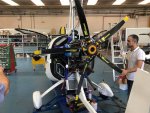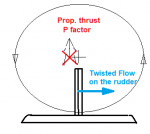rdalcanto
Member
A year ago when I had the opportunity to fly several different gyros, including the AR1, Magni M24, Cavalon, Tercel, and Taurus, I noticed that I had more trouble keeping the Tercel and Taurus on the centerline on takeoff when flying solo (not a problem with the weight of two people). At the time, I attributed it to the dual rudders being outside the prop wash on the Trendak gyros. It turns out that the issue was actually the power increase and p-factor increase from the more powerful Trendak engines. I was able to fly a 914 equipped M24 for several months while I waited for mine to arrive from Italy (and then have the SBs that were out on the 915 engine). When flying solo, keeping the 915 powered M24 on the centerline can be a real challenge compared to the 914 powered version (otherwise identical gyros). Gyros are light weight, and the p-factor when you go to full throttle early in the T.O. run pulls the gyro very hard to the left. It is completely controllable with a lot of right rudder, but that also means the nose wheel is turned a lot should it touch back down while trying to balance on the mains. This is less of an issue in a gyro like the Magni that has a castering nose wheel, but it is still an issue. I would strongly recommend, based on my experience, to not put low time gyro pilots in a gyro with that much power. Having a lot of power is great for fast climbs and is safer when we talk about not getting behind the power curve, and everyone wants the latest and greatest engine. However, getting safely off the ground is priority number one. That being said, if there is plenty of runway, the engine torque with the 915 is less of an issue if you slowly add the power as you accelerate down the runway, as opposed to applying it quickly while just starting the take off run.



